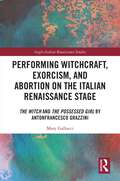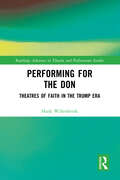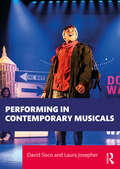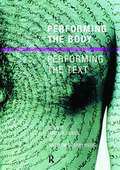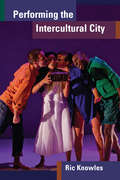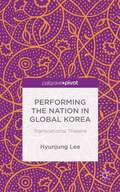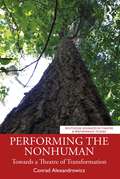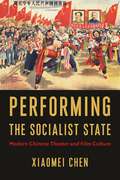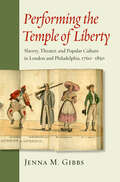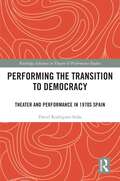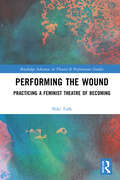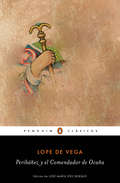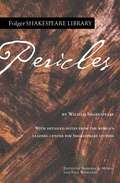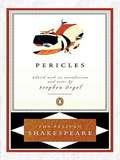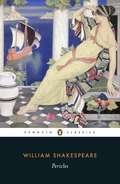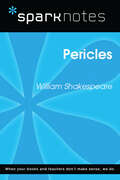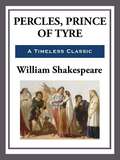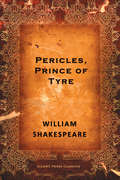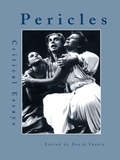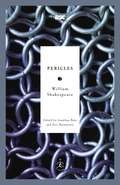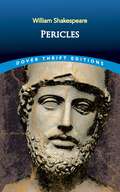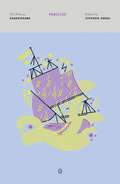- Table View
- List View
Performing Witchcraft, Exorcism, and Abortion on the Italian Renaissance Stage: The Witch and The Possessed Girl by Antonfrancesco Grazzini (Anglo-Italian Renaissance Studies)
by Mary GallucciAntonfrancesco Grazzini’s plays, La Spiritata (The Possessed Girl) and La Strega (The Witch), are available in English for the first time, with notes and an “Introduction.” These plays deal with witchcraft, superstition, sexuality, and abortion. The context for such themes is analyzed in the “Introduction.” Grazzini enhanced literary drama with elements from popular performances. He influenced other playwrights, including in England, where The Possessed Girl was adapted as the Elizabethan comedy, The Bugbears. Writer and linguist John Florio used Grazzini’s plays in his lexicon of Italian for English learners. Grazzini celebrated artistic and popular traditions of Renaissance Florence; he is significant for writing and preserving many literary genres, especially the burlesque and carnivalesque. He participated in Florentine spectacle and theater, as a writer of plays, a composer of interludes, and a chronicler of festive events. His importance to the development of the Italian language is evident in his plays.
Performing for the Don: Theaters of Faith in the Trump Era (Routledge Advances in Theatre & Performance Studies)
by Hank WillenbrinkThis volume examines the intersection of political power and religion during the presidency of Donald Trump through an examination of performance. This study begins with an examination of white evangelical Christian support for Trump through readings of the 2018 film The Trump Prophecy, based on a book of the same name, and The Faith of Donald J. Trump, a "spiritual biography" of the former president by veteran Christian reporters David Brody and Scott Lamb. White evangelicals Christianized Trump during his run for office in 2016 and Trump’s ascension to the presidency broke down barriers between church and state in service of dominionistic Christian aims. This exploration then looks at the conservative Catholicism through an exploration of Heroes of the Fourth Turning, a finalist for the 2019 Pulitzer Prize for Drama by Will Arbery, and Rod Dreher’s The Benedict Option. While Trump’s connection to evangelicals is well documented, conservative Catholics like Attorney General Bill Barr and Supreme Court Justice Amy Coney Barrett took on pivotal roles during the Trump administration demonstrating the significance of conservative Catholicism to his presidency. The author finally examines the "cult" of Trump on the internet by interrogating the performance of spirituality in pro-Trump conspiracy theories like QAnon. This book will be of great interest not only to theatre and performance studies scholars but also scholars with interests in political and religious studies.
Performing in Contemporary Musicals
by David Sisco Laura JosepherPerforming in Contemporary Musicals brings into sharp focus the skills performers must possess when tackling shows that are newly written, in development, or somewhere in between. The authors bust myths about contemporary musical theatre and analyze the development timelines of musicals from around the world. They also explore how performers can become invaluable to a creative team by developing the skills needed to move a new musical forward including: contemporary acting and singing techniques, dramaturgy, quickly picking up new material, and collaboration. Each chapter features insightful industry interviews, recommended activities, an extensive reading list, and an online companion for further study. This textbook is the only comprehensive resource that provides an overview of the development process of a new musical while guiding musical theatre performers to be fruitful collaborators in a new works scenario.
Performing the Body/Performing the Text
by Amelia Jones Andrew StephensonThis book explores the new performativity in art theory and practice, examining ways of rethinking interpretive processes in visual culture. Since the 1960s, visual art practices - from body art to minimalism - have taken contemporary art outside the museum and gallery; by embracing theatricality and performance and exploding the boundaries set by traditional art criticism. The contributors argue that interpretation needs to be recognised as much more dynamic and contingent. Offering its own performance script, and embracing both canonical fine artists such as Manet, De Kooning and Jasper Johns, and performance artists such as Vito Acconci and Gunter Brus, this book offers radical re-readings of art works and points confidently towards new models for understanding art.
Performing the Intercultural City
by Ric KnowlesIn 1971, Canada became the first country to adopt an official policy of multiculturalism. Performing the Intercultural City explores how Toronto—a representative global city in this multicultural country—stages diversity through its many intercultural theater companies and troupes. The book begins with a theoretical introduction to theatrical interculturalism. Subsequent chapters outline the historical and political context within which intercultural performance takes place; examine the ways in which Indigenous, Filipino, and Afro-Caribbean Canadian theater has developed play structures based on culturally specific forms of expression; and explore the ways that intercultural companies have used intermediality, modernist form, and intercultural discourse to mediate across cultures. Performing the Intercultural City will appeal to scholars, artists, and the theater-going public, including those in theater and performance studies, urban studies, critical multiculturalism studies, diaspora studies, critical cosmopolitanism studies, critical race theory, and cultural studies.
Performing the Nation in Global Korea: Transnational Theatre
by Hyunjung LeeThis book illustrates how local awareness of Western cultural hegemonic entities such as Broadway and Shakespeare have been implemented within South Korean theatre in the global era. With a focus on performances that targeted global audiences, Lee explores the ways in which Korea's nationalistic desires for global visibility are projected on stage.
Performing the Nonhuman: Towards a Theatre of Transformation (ISSN)
by Conrad AlexandrowiczThis book radically reimagines theatre/performance pedagogy and dramaturgy in response to the accelerating climate crisis.This text is founded upon the principle that the theatre is the most anthropocentric of all the arts: the means of its representation, the human figure, is identical with its conventional object, the human narrative, broadly considered. In order to respond ethically to the climate crisis, it must expand its range to include performing as/in response to the nonhuman. Conrad Alexandrowicz concisely explores theoretical approaches to the other‑than‑human, found in the work of, among others, Jane Bennett, Timothy Morton, Rosi Braidotti, and Cary Wolfe. The implications of this move are far‑reaching and commence with displacing realism from its traditional position of dominance. The practices of 20th century physical theatre visionaries such as Tadeusz Kantor, Jacques Lecoq, and Jerzy Grotowski are revisited and reconsidered for their applicability to forms of theatre that might serve the needs of establishing storytelling deriving from nonhuman phenomena. This logically leads to the matter of responding appropriately to Indigenous ways of knowing and being. The work finds guidance in Indigenous, pre‑scientific ways of knowing and being, such as those articulated by Robin Wall Kimmerer (Braiding Sweetgrass, 2013). In contemplating our kinship with vegetative life, the work finds inspiration in the latest research into the ways tree communities communicate, collaborate, and share resources, including the work of Suzanne Simard (Finding the Mother Tree, 2021). It next imagines transformations in how theatre is situated, delivered, and received and considers the ways in which the performer/spectator binary may have to be reconfigured, with particular reference to Grotowski’s experiments in participatory theatre. It poses an even more provocative question: is such theorized performance work pointing in the direction of some re‑imagined version of ritual and ceremony that may find antecedents in pre‑Christian European belief and practice? Finally, it locates such eco‑theatre in the realm of healing: climate anxiety, depression, and grief on the part of instructors, students, and artists will require us to consider and activate the healing power of the art form; perhaps, the core purpose of all the arts will shift to support the need to generate solace in times of fear, anger, and uncertainty.This book is intended for instructors, both scholars and performance pedagogues, in theatre and performance studies, as well as graduate and undergraduate students in these areas.
Performing the Socialist State: Modern Chinese Theater and Film Culture
by Xiaomei ChenPerforming the Socialist State offers an innovative account of the origins, evolution, and legacies of key trends in twentieth-century Chinese theater. Instead of seeing the Republican, high socialist, and postsocialist periods as radically distinct, it identifies key continuities in theatrical practices and shared aspirations for the social role and artistic achievements of performance across eras.Xiaomei Chen focuses on the long and remarkable careers of three founders of modern Chinese theater and film, Tian Han, Hong Shen, and Ouyang Yuqian, and their legacy, which helped shape theater cultures into the twenty-first century. They introduced Western plays and theories, adapted traditional Chinese operas, and helped develop a tradition of leftist theater in the Republican period that paved the way for the construction of a socialist canon after 1949. Chen investigates how their visions for a free, democratic China fared in the initial years after the founding of the People’s Republic, briefly thriving only to founder as artists had to adapt to the Communist Party’s demand to produce ideologically correct works. Bridging the faith play and “antiparty plays” of the 1950s, the “red classics” of the 1960s, and their reincarnations in the postsocialist period, she considers the transformations of the depictions of women, peasants, soldiers, scientists, and revolutionary history in plays, operas, and films and examines how the market economy, collective memories, star culture, social networks, and state sponsorship affected dramatic productions.Countering the view that state interference stifles artistic imagination, Chen argues that theater professionals have skillfully navigated shifting ruling ideologies to create works that are politically acceptable yet aesthetically ingenious. Emphasizing the power, dynamics, and complexities of Chinese performance cultures, Performing the Socialist State has implications spanning global theater, comparative literature, political and social histories, and Chinese cultural studies.
Performing the Temple of Liberty: Slavery, Theater, and Popular Culture in London and Philadelphia, 1760–1850 (Early America: History, Context, Culture)
by Jenna M. GibbsHow popular theater, including blackface characters, reflected and influenced attitudes toward race, the slave trade, and ideas of liberty in early America.Jenna M. Gibbs explores the world of theatrical and related print production on both sides of the Atlantic in an age of remarkable political and social change. Her deeply researched study of working-class and middling entertainment covers the period of the American Revolution through the first half of the nineteenth century, examining controversies over the place of black people in the Anglo-American moral imagination. Taking a transatlantic and nearly century-long view, Performing the Temple of Liberty draws on a wide range of performed texts as well as ephemera—broadsides, ballads, and cartoons—and traces changes in white racial attitudes.Gibbs asks how popular entertainment incorporated and helped define concepts of liberty, natural rights, the nature of blackness, and the evils of slavery while also generating widespread acceptance, in America and in Great Britain, of blackface performance as a form of racial ridicule. Readers follow the migration of theatrical texts, images, and performers between London and Philadelphia. The story is not flattering to either the United States or Great Britain. Gibbs's account demonstrates how British portrayals of Africans ran to the sympathetic and to a definition of liberty that produced slave manumission in 1833 yet reflected an increasingly racialized sense of cultural superiority. On the American stage, the treatment of blacks devolved into a denigrating, patronizing view embedded both in blackface burlesque and in the idea of "Liberty," the figure of the white goddess.Performing the Temple of Liberty will appeal to readers across disciplinary lines of history, literature, theater history, and culture studies. Scholars and students interested in slavery and abolition, British and American politics and culture, and Atlantic history will also take an interest in this provocative work.
Performing the Transition to Democracy: Theater and Performance in 1970s Spain (ISSN)
by David Rodríguez-SolásThis book examines troupes, plays, festivals, performative practices, and audiences active during the final years of the Franco dictatorship and the beginning of the transition to democracy.This period, spanning 1968 to 1982, is considered the historical moment that most directly shaped contemporary Spanish politics and society. The dominant narrative of the Transition has long portrayed it as a normalized, non-confrontational, and consensual process steered by political elites. But the world of Spanish theater tells a very different story - one in which ordinary Spaniards played a vital role in the transition to democracy. The chapters of this book draw on censorship files, photographs, audiovisual and textual material, and the author’s own interviews with more than a dozen audience and troupe members. Using these sources, David Rodriguez-Solas examines the notable experimentation during this period with theatrical performance and music; the establishment of performing spaces and festivals; the development of touring networks as a way to evade censorship; and the creation of networks of support that opposed diverse forms of violence and repression.This study will be of great interest to students and scholars interested in theater and the cultural and political history of Spain in the 1960s and 1970s.
Performing the Wound: Practicing a Feminist Theatre of Becoming (Routledge Advances in Theatre & Performance Studies)
by Niki TulkThis book offers a matrixial, feminist-centered analysis of trauma and performance, through examining the work of three artists: Ann Hamilton, Renée Green, and Cecilia Vicuña. Each artist engages in a multi-media, or “combination” performance practice; this includes the use of site, embodied performance, material elements, film, and writing. Each case study involves traumatic content, including the legacy of slavery, child sexual abuse and environmental degradation; each artist constructs an aesthetic milieu that invites rather than immerses—this allows an audience to have agency, as well as multiple pathways into their engagement with the art. The author Niki Tulk suggests that these works facilitate an audience-performance relationship based on the concept of ethical witnessing/wit(h)nessing, in which viewers are not positioned as voyeurs, nor made to risk re-traumatization by being forced to view traumatic events re-played on stage. This approach also allows agency to the art itself, in that an ethical space is created where the art is not objectified or looked at—but joined with. Foundational to this investigation are the writings of Bracha L. Ettinger, Jill Bennett and Diana Taylor—particularly Ettinger’s concepts of the matrixial, carriance and border-linking. These artists and scholars present a capacity to expand and articulate answers to questions regarding how to make performance that remains compelling and truthful to the trauma experience, but not re-traumatizing. This study will be of great interest to students and scholars of performance studies, art history, visual arts, feminist studies, theatre, film, performance art, postcolonialism, rhetoric and writing.
Peribáñez y el Comendador de Ocaña (Los mejores clásicos #Volumen)
by Lope de VegaLos mejores libros jamás escritos Edición de José María Díez Borque, Catedrático de Literatura Española de la Universidad Complutense de Madrid Peribáñez y el Comendador de Ocaña reúne todas las cualidades que hicieron de Lope de Vega una de las grandes figuras de la literatura europea. El rechazo de los preceptos de la poética aristotélica, la concepción del teatro como entretenimiento y el conocimiento preciso de los mecanismos del drama alcanzan aquí su muestra más ajustada e intensa. Estas son algunas de las razones por las que no es solo recomendable para adentrarse en la obra de Lope de Vega, sino también en el teatro español del Siglo de Oro. Esta edición incluye una introducción que contextualiza la obra, un aparato de notas, una cronología y una bibliografía esencial, así como también varias propuestas de discusión y debate en torno a la lectura. Está al cuidado de José María Díez Borque, catedrático de literatura española de la Universidad Complutense de Madrid. «Exceso es ya tan gran desconfianza, porque ninguno amó sin esperanza.»
Pericles
by William Shakespeare Paul Werstine Barbara MowatPericles tells of a prince who risks his life to win a princess, but discovers that she is in an incestuous relationship with her father and flees to safety. He marries another princess, but she dies giving birth to their daughter. The adventures continue from one disaster to another until the grown-up daughter pulls her father out of despair and the play moves toward a gloriously happy ending. The authoritative edition of Pericles from The Folger Shakespeare Library, the trusted and widely used Shakespeare series for students and general readers, includes: -Freshly edited text based on the best early printed version of the play -Full explanatory notes conveniently placed on pages facing the text of the play -Scene-by-scene plot summaries -A key to the play’s famous lines and phrases -An introduction to reading Shakespeare’s language -An essay by a leading Shakespeare scholar providing a modern perspective on the play -Fresh images from the Folger Shakespeare Library’s vast holdings of rare books -An annotated guide to further reading Essay by Margaret Jane Kidnie The Folger Shakespeare Library in Washington, DC, is home to the world’s largest collection of Shakespeare’s printed works, and a magnet for Shakespeare scholars from around the globe. In addition to exhibitions open to the public throughout the year, the Folger offers a full calendar of performances and programs. For more information, visit Folger.edu.
Pericles
by William Shakespeare Stephen Orgel"I feel that I have spent half my career with one or another Pelican Shakespeare in my back pocket. Convenience, however, is the least important aspect of the new Pelican Shakespeare series. Here is an elegant and clear text for either the study or the rehearsal room, notes where you need them and the distinguished scholarship of the general editors, Stephen Orgel and A. R. Braunmuller who understand that these are plays for performance as well as great texts for contemplation." (Patrick Stewart) The distinguished Pelican Shakespeare series, which has sold more than four million copies, is now completely revised and repackaged. Each volume features: * Authoritative, reliable texts * High quality introductions and notes * New, more readable trade trim size * An essay on the theatrical world of Shakespeare and essays on Shakespeare's life and the selection of texts
Pericles
by William ShakespearePericles, Prince of Tyre, must solve a riddle in order to marry the daughter of the King of Antioch, or be put to death. But when the answer reveals a horrific secret, the young man faces his greatest dilemma. Danger and adventure follow as Pericles flees the city to find his fortune elsewhere, in a romantic drama of families lost and reunited, evil punished and virtue rewarded.
Pericles (SparkNotes Literature Guide Series)
by SparkNotesPericles (SparkNotes Literature Guide) by William Shakespeare Making the reading experience fun! Created by Harvard students for students everywhere, SparkNotes is a new breed of study guide: smarter, better, faster. Geared to what today's students need to know, SparkNotes provides: *Chapter-by-chapter analysis *Explanations of key themes, motifs, and symbols *A review quiz and essay topicsLively and accessible, these guides are perfect for late-night studying and writing papers
Pericles (The New Cambridge Shakespeare)
by William Shakespeare edited by Doreen DelVecchio Antony HammondOver the past two decades there has been a resurgence of theatrical interest in Shakespeare's Pericles, which has been rescued from comparative neglect and is now frequently performed. This development is charted in the introduction to this edition, which differs radically from any other currently available. Doreen DelVecchio and Antony Hammond reject the critical orthodoxies of a corrupt text and divided authorship. Instead they show the play to be a unified aesthetic experience. The result is a more enthusiatic view of Pericles than that of other editions.
Pericles, Prince of Tyre
by William ShakespearePerhaps one of Shakespeare's most adventure-filled plays, "Pericles" follows the extended sailing journeys of a young prince. Pericles is forced to flee Antioch when he correctly guesses a riddle that reveals the incestuous activity of King Antiochus. Unable to stay at home in Tyre because of Antiochus' vengeance, he sails away and ends up shipwrecked in Pentapolis, where he fights for and wins a princess named Thaisa. The trials and tribulations of this couple and their daughter Marina fill the remaining acts of "Pericles" with grief and trepidation, as well as joy and a truly heartwarming reunion. A laudable component of Shakespeare's collection of plays, "Pericles, Prince of Tyre" is a compelling story of family and struggle that resonates with readers even today.
Pericles, Prince of Tyre
by William ShakespeareAfter Prince Pericles puzzles out a terrible secret about the king of Antioch, he flees the city and sets sail on his ship. His adventures bring him love and marriage, but his greatest tragedies and triumps lay ahead as he voyages home.
Pericles: Critical Essays (Shakespeare Criticism #Vol. 23)
by David SkeelePericles: Critical Essays brings together the most essential critical essays and theatrical reviews of Shakespeare's play from the late 17th century to the present, providing a representative gathering of critical opinion of Pericles over the centuries. David Skeele's introduction identifies the critical issues and problems the play has raised, cites and evaluates significant critical works, and gives readers a guide to research on the play.
Pericles: Prince Of Tyre (Modern Library Classics)
by William Shakespeare Jonathan Bate Eric Rasmussen"This world to me is but a ceaseless storm Whirring me from my friends." --Pericles Eminent Shakespearean scholars Jonathan Bate and Eric Rasmussen provide a fresh new edition of this classic tragicomedy of good and evil in many guises. THIS VOLUME ALSO INCLUDES MORE THAN A HUNDRED PAGES OF EXCLUSIVE FEATURES: * an original Introduction to Pericles * incisive scene-by-scene synopsis and analysis with vital facts about the work * commentary on past and current productions based on interviews with leading directors, actors, and designers * photographs of key RSC productions * an overview of Shakespeare's theatrical career and chronology of his plays Ideal for students, theater professionals, and general readers, these modern and accessible editions from the Royal Shakespeare Company set a new standard in Shakespearean literature for the twenty-first century.From the Trade Paperback edition.
Pericles: With The Story Of The Prince Of Tyre... . (Dover Thrift Editions)
by William ShakespeareThis romantic drama portrays the travails of a wandering prince and the redemptive powers of a daughter's love. Driven from one end of the Mediterranean to another by the winds of fate, Pericles endures loss and heartbreak before his odyssey ends in a miraculous reunion. Shipwreck, famine, and other disasters punctuate this wondrous tale, in which a knight in rusty armor fights for his true love and a princess kidnapped by pirates retains her honor by setting a virtuous example for her captors.Prologues delivered in the character of medieval English poet John Gower introduce each act of this unusual play, whose authorship has long been disputed. Written late in Shakespeare's career, Pericles was enormously popular in the seventeenth century and was the first of the playwright's dramas to be staged after the Restoration. The play fell into neglect until recent years, and now its charms are being rediscovered by modern audiences.
Pericles: With The Story Of The Prince Of Tyre... . (The Pelican Shakespeare)
by William ShakespeareThe acclaimed Pelican Shakespeare series edited by A. R. Braunmuller and Stephen Orgel The legendary Pelican Shakespeare series features authoritative and meticulously researched texts paired with scholarship by renowned Shakespeareans. Each book includes an essay on the theatrical world of Shakespeare’s time, an introduction to the individual play, and a detailed note on the text used. Updated by general editors Stephen Orgel and A. R. Braunmuller, these easy-to-read editions incorporate over thirty years of Shakespeare scholarship undertaken since the original series, edited by Alfred Harbage, appeared between 1956 and 1967. With definitive texts and illuminating essays, the Pelican Shakespeare will remain a valued resource for students, teachers, and theater professionals for many years to come. For more than seventy years, Penguin has been the leading publisher of classic literature in the English-speaking world. With more than 1,700 titles, Penguin Classics represents a global bookshelf of the best works throughout history and across genres and disciplines. Readers trust the series to provide authoritative texts enhanced by introductions and notes by distinguished scholars and contemporary authors, as well as up-to-date translations by award-winning translators.
Perilous Passions: Ethics and Emotion in Early Modern Spain (Toronto Iberic #87)
by Hilaire KallendorfCan feelings be wrong? Scientists agree that emotions contain both a cognitive and a physiological component. The cognitive part can be modified, while the physiological response is largely involuntary. In religious terms, the answer is clear in its legislation of heart motives: love your enemies, lust is equivalent to adultery, hate is the same thing as murder. In Perilous Passions, Hilaire Kallendorf draws on early modern Spanish theatre to reveal how emotions have always been understood as central to ethics. Starting with a treatise on emotion, On the Passions of the Soul by Juan Luis Vives (1493–1540), Kallendorf uses pairs of opposing emotions – love/hatred, desire/aversion, joy/sorrow, hope/despair, and courage/fear – to explore how they are depicted in Golden Age plays. The book pinpoints and probes intersections of feelings with morality. It asks: Do emotions bear positive or negative ethical overtones? Which emotions are more conducive to virtue? Are passions perceived as perilous in early modern Spain, in agreement with Neostoic principles? Or does the Catholic liturgy’s emphasis on involving the corporeal senses in worship mean that bodily sensations, including feelings, are accorded pride of place – especially in drama? In asking these questions, Perilous Passions argues for the significance of theatre in emotional education.
